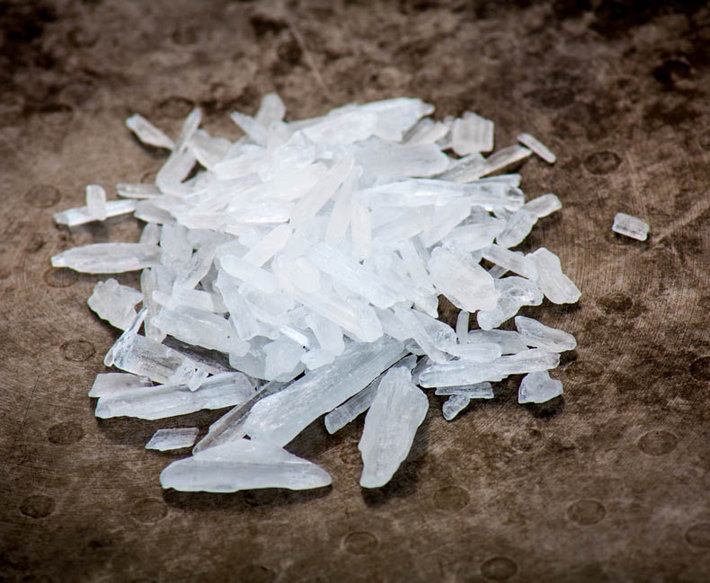‘Ice’ - the Drug

The drug referred to as “ice” is a form of methamphetamine, a powerful and addictive stimulant that is sold and used illicitly.
When methamphetamine is produced, then further refined and allowed to crystallize, it becomes “ice” methamphetamine. When the drug doesn’t go through this additional process, it is sold and used as a powder or chunky substance.
Ice methamphetamine may look like small pieces of glass. It can be fairly clear or have a slight color and have sharp edges to each crystal.
Crystal methamphetamine is pure enough to burn so it is usually smoked. Some users also dissolve crystal meth and inject it but many drug users still attach a stigma to injection drug use.
The impurities in powdered meth do not allow it to burn. Powdered meth can be snorted, ingested or be dissolved and then injected.
When crystal meth is burned and the smoke is inhaled, a brief, intense rush is reported. When a person uses powder meth and injects it, they get a similar rush. Snorting powder meth produces a longer high without the initial rush.
Crystal meth can be called by many different names, depending on where you are. Here is a list of the most common names: Batu, Blade, Cristy, Crystal glass, Hot ice, LA glass, LA ice, Quartz, Shabu, Shards, Stovetop, Super ice, Tina, Ventana.
Ice is Physical and Mentally Damaging

Those who use ice can quickly become addicted. One report estimated that 80% of users do become addicted. It is common for meth addicts to lose their ability to care for themselves and children or others they are responsible for. The chemical itself is corrosive and damaging. Use can cause inflammation of the heart and can severely damage the teeth, requiring full dentures as replacements. Meth users may hallucinate that bugs are crawling under their skin and try to scratch and dig them out, resulting in sores on their faces or elsewhere on their bodies.
Meth use also can damage blood vessels, due to its stimulating effect that raises blood pressure and body temperature. This can contribute to strokes.
A meth addict is often paranoid and may if use is heavy, have psychotic episodes. This can definitely land a person in trouble with law enforcement. The drug can also cause tremors, convulsions, aggressive or violent behavior, often directed at others in the same household.
A study of meth users being admitted to hospitals in Australia revealed that they were more agitated, aggressive and violent than other types of drug users. They were significantly less alert and cooperative and were far more likely to be accompanied by the police when they were brought to the hospital.
Because a person using ice quickly develops a tolerance, their dosages may also increase rapidly, leading right into addiction.
Where Does Ice Come From?
Methamphetamine and amphetamines are sold and abused around the world, especially in Asia. But in these areas, meth and amphetamines do not come in the crystal form. That is the product of Superlabs in Mexico and additional labs that Mexican drug cartels have established in Central and Southern California. These labs are capable of producing ten to a hundred pounds of methamphetamine at a time.

In passenger cars or trucks or by package services, the ice drug then makes its way across the United States. A hundred pound package of ice can sell for as much as $4.5 million.
It’s hard to determine how many people use ice methamphetamine rather than powder meth since statistics and studies do not differentiate the ice drug from powder methamphetamine. In North America, about 3.5 million people used methamphetamine in one form or another, in 2009. Use of meth even extended into US high schools. Also in 2009, one percent of eighth-grade students used methamphetamine, along with 1.6% of tenth graders and 1.2% of seniors.
What Does a Person Look like When They are using Ice Drug?
They will have dilated pupils, may breathe more quickly than usual and feel sweaty and complain about being hot. They will seldom if ever eat. They may complain of nausea, headache, and dizziness. As long as they have meth on hand, they will not sleep until they simply hit collapse which may be days or as long as a week–sooner if they run out the drug. When they crash, they may sleep for a long period and feel exhausted and depressed when they get up. It is likely that they will crave more of the drug at this point to get rid of the exhaustion and depression.
While high, they will probably appear jittery, talkative and active. In more severe situations of heavier drug use, they may manifest visual hallucinations.
In their belongings, you may find small plastic bags with shreds of ice drug remaining in them and they may have narrow glass pipes with black residue remaining behind.
 ®
®